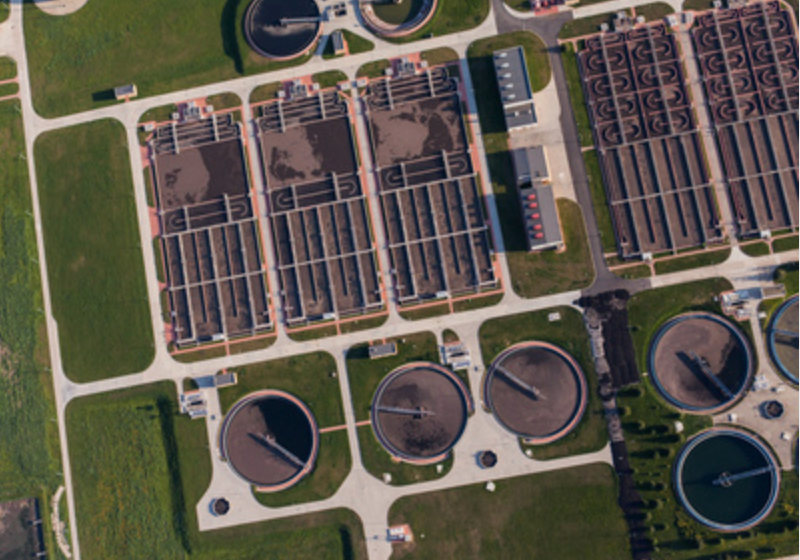Construction of Secondary Sedimentation Tank
In sewage treatment process,the sedimentation tank after biological treatment is usually called Secondary Sedimentation Tank or Final Sedimentation Tank.
The function of the secondary sedimentation tank is to separate the sludge and water, clarify the mixed liquor, concentrate the sludge and return the separated sludge to the biological treatment section. Its effect directly affects the quality of effluent and the concentration of returned sludge.
Structure and Characteristics of Secondary Sedimentation Tank
- Water Inlet Device:
The activated sludge mixed liquor entering the secondary sedimentation tank also has its own characteristics in nature, that is, the concentration of the activated sludge mixed liquor is high (2 000 - 4 000 mg/L) and has flocculation performance, so it belongs to layered sedimentation.
When it settles, there is a clear interface between mud and water, the flocs form a whole and sink together, and the settling speed of the initial mud water interface is fixed, which is only related to the initial concentration. The concentration of the mixed liquid entering the secondary sedimentation tank is higher than that of the clarified liquid in the secondary sedimentation tank. The secondary flow phenomenon is easy to occur in the secondary sedimentation tank. The relative density of the influent mixed liquid is large, and it flows in the lower part of the tank.
- Sedimentation Area:
The mixed liquid entering the secondary sedimentation tank is a three-phase mixture of mud, water and gas. The flow rate in the inlet central pipe should not exceed 0. I - 0.3 m/s to facilitate the separation of gas and water and improve the separation effect of the clarification area. The flow velocity in the clarification area of the sedimentation tank is smaller (about 0.0004 m/s), because the task of separating mud from water is more important.
- Effluent Device:
Another feature of activated sludge in secondary sedimentation tank is light weight, easy to be taken away by effluent, and easy to produce secondary flow, which makes the actual water discharge section much smaller than the designed one. Therefore, when designing the secondary sedimentation tank, the maximum allowable horizontal velocity should be less than half of that of the primary sedimentation tank. The outlet overflow of the tank should be buried within a certain distance at the other end of the tank; The radial flow secondary sedimentation tank can also improve the flow distance and sedimentation effect of mixed liquid in the tank by means of peripheral inflow and peripheral outflow.
- Sludge Area:
The activated sludge in the secondary sedimentation tank is light and easy to decay. For the secondary sedimentation tank with hydrostatic sludge discharge, its hydrostatic head can be reduced to 0.9 m, and the included angle between the bottom slope of the sludge bucket and the horizontal should not be less than 50 °, so that the sludge can slide down in time and discharge smoothly.
For the sedimentation tank with scraper suction mixer for sludge discharge, the sludge is siphoned into the sludge collecting tank by the difference between the water level in the tank and the water level in the sludge collecting tank, and then collected in the sludge drainage well, where the sludge is discharged by the sludge pump.
The Common Abnormal Phenomena of Secondary Sedimentation Tank
1. The content of suspended solids in the effluent of secondary sedimentation tank increases
2. The dissolved oxygen in the effluent of secondary sedimentation tank is low or high
3. Sludge floatation in secondary sedimentation tank
4. Black lump sludge appears on the surface of secondary sedimentation tank
If the secondary sedimentation tank is set unreasonably, even if the biological treatment effect is good, the content of dissolved organic matter in the mixed solution is already small, the effect of mud water separation of the mixed solution in the secondary sedimentation tank is not ideal, and the effluent quality may still be unqualified.
If the sludge thickening effect is not good, it is difficult to ensure the amount of microorganisms returned to the aeration tank. The reduction of the concentration of the aeration mixture will lead to the decline of the sewage treatment effect, which will affect the effluent quality.
#QDEVU #SEWAGETREATMENT #WASTEWATERTREATMENT #WATERTREATMENT



